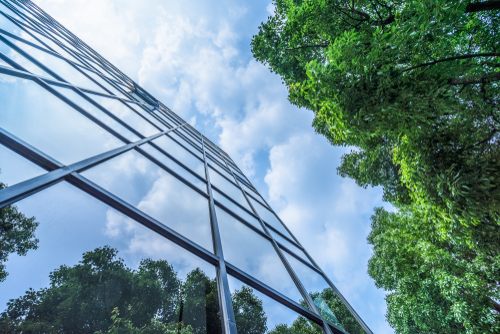A building can feature every visible marker of sustainability—efficient HVAC, LED lighting, smart appliances and controls, even solar panels—and still fall short. How is this possible? The answer is often hidden just out of sight: Lurking in cracks and gaps throughout a building’s envelope and HVAC system, uncontrolled air leakage is silently undermining nearly every efficiency investment.

These leaks quietly waste energy, inflate utility costs, compromise indoor air quality (IAQ), and erode the effectiveness of even the most advanced HVAC systems. Simply put, if a building leaks, it cannot perform as designed and deliver on the promise of efficiency. For building owners and facilities managers, that makes airtightness the critical benchmark to prioritize—a defining factor that determines whether efficiency investments succeed or silently fall short.
Why Airtightness Matters
Across the country, local codes and standards are raising the bar. Recent state-level moves, such as New York’s adoption of an all-electric building code, underscore a growing regulatory emphasis on high-performance construction and measurable efficiency outcomes. At the same time, standards like Passive House, ASHRAE 189.1, and the 2021 International Energy Conservation Code (IECC) are increasingly prioritizing airtightness and verified leakage reduction as a core metric. For modern buildings comprising the next generation of efficient design, airtightness is no longer optional.
Yet, in practice, leakage remains one of the most overlooked performance gaps, with many projects, particularly retrofits, still missing the mark. While energy use, HVAC efficiency, and lighting are routinely measured, leakage rates are rarely quantified; this is in part because, compared to the more “visible” metrics, leaks are hidden, harder to detect without specialized testing equipment, and not always required or enforced consistently across building codes. The result is a persistent blind spot: Many building professionals don’t realize how significantly leakage can undermine performance, leaving it as the monster under the bed that too often goes unchecked.
Despite this oversight, research indicates that even minor leaks can account for 10-33% of heating and cooling energy loss, depending on the building type and climate. Duct leakage alone can slash system efficiency by up to 30%, dropping a high-efficiency heat pump’s SEER rating — the standard measure of cooling performance—down several points. In real terms, this means a system designed to perform like the latest model can end up operating like an outdated, less efficient unit.
Beyond energy waste, uncontrolled airflow introduces dust, allergens, and moisture that compromise occupant health and accelerate wear on building materials. For owners and facilities managers, that means higher costs, greater system strain, and a building that underdelivers on both comfort and compliance.
By treating airtightness as a critical measure rather than an afterthought, owners and managers can ensure that their strategic efficiency upgrades deliver the intended benefits, satisfy emerging standards and requirements, and provide occupants with healthier, more enjoyable spaces.
From Overlooked Problem to Strategic Investment
Addressing leakage can start with traditional methods like caulking and weatherstripping, but hidden, hard-to-reach gaps in ductwork and wall cavities demand more advanced solutions. Advanced sealing technologies, now deployed in tens of thousands of buildings worldwide, can reduce leakage by as much as 95% and deliver measurable IAQ and energy benefits almost immediately. Studies from UC Davis, the U.S. Department of Energy, and Passive House projects show 15-30% HVAC energy savings after these kinds of tech-enabled sealing interventions.
As the industry increasingly shifts toward performance-based metrics rather than prescriptive checklists, verified, documented air leakage reduction is a defining benchmark for both retrofits and new construction. Owners and managers who prioritize airtightness alongside efficiency measures like insulation, HVAC, and lighting achieve stronger returns on investment, healthier indoor environments, and higher tenant satisfaction.
The Bottom Line
Airtightness is more than a code requirement; it’s an essential business decision. In an era of expanding electrification policies and evolving sustainability standards, the facilities that measure, seal, and monitor leakage will consistently outperform those that don’t.
Air leakage is no longer a hidden problem. It’s a key metric that separates buildings that only appear efficient from those that truly are.
Christian Weeks is the vice president of Aeroseal Commercial.
ALSO READ: 10 Ways to Keep Heat and Money from Going Out the Window
